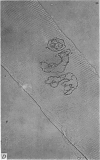Abstract
1. The morphology of nerve terminals and sub-neural apparatuses was examined in the muscles of normal and dystrophic adult mice of the Bar Harbor 129 ReJ strain. Nerve terminals were larger in dystrophic muscles than in normal muscles and nerve terminal sprouting was evident in about 50% of the dystrophic muscles fibres. End-plate area was positively correlated with muscle fibre diameter in both normal and dystrophic muscles. 2. Polynueronal innervation was found in only 1% of dystrophic muscle fibres impaled with micro-electrodes. 3. Miniature end-plate potential amplitude was positively correlated with muscle fibre input resistance in both normal and dystrophic muscles. There was however, a greater than normal variation in the amplitudes of m.e.p.p.s recorded from individual dystrophic muscle fibres. 4. Quantum contents of end-plate potentials were estimated in normal and dystrophic mouse nerve-muscle preparations partially blocked with D-tubocurarine. The quantum content of e.p.p.s seemed to be related to muscle fibre diameter, and in dystrophic muscles the characteristics of evoked release were indistinguishable from normal. 5. It was concluded that the nerve terminal sprouting and the expansion of end-plate area which were observed in dystrophic muscles are not a consequence of any form of denervation, but represent an attempt by the axon to expand the area of synaptic contact in hypertrophied muscle fibres.
Full text
PDF

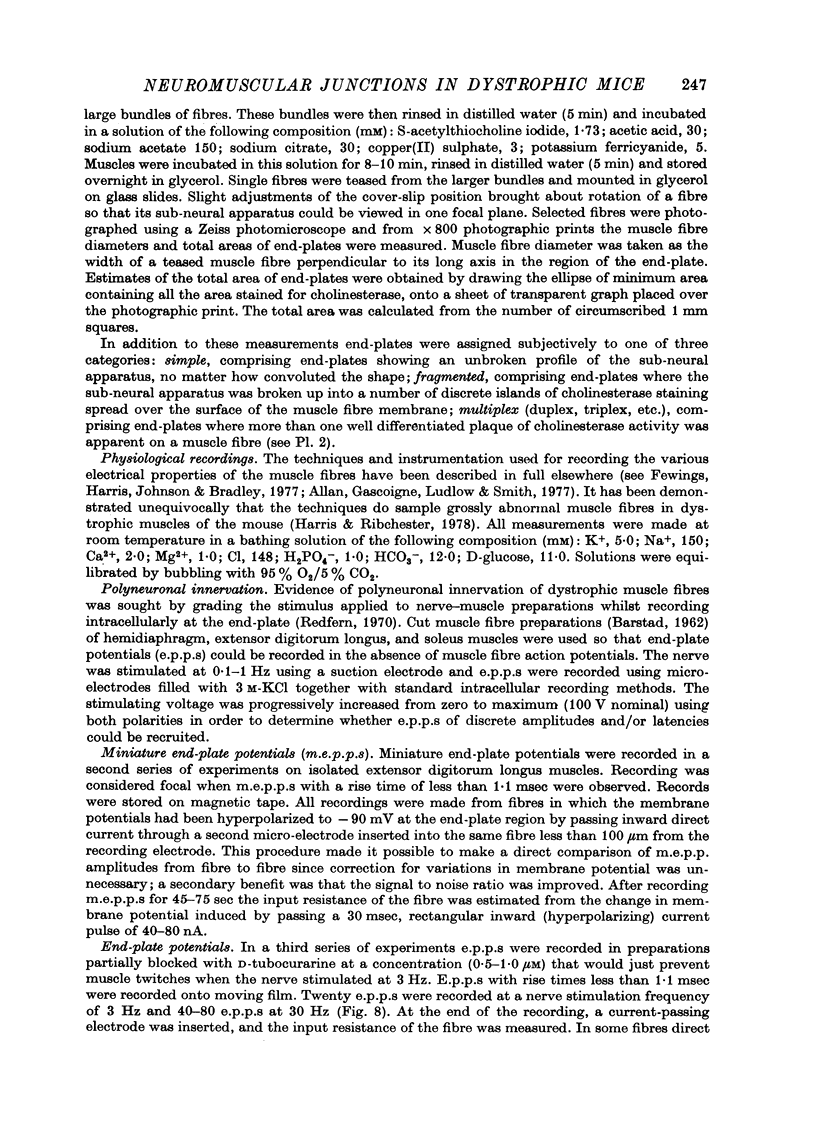





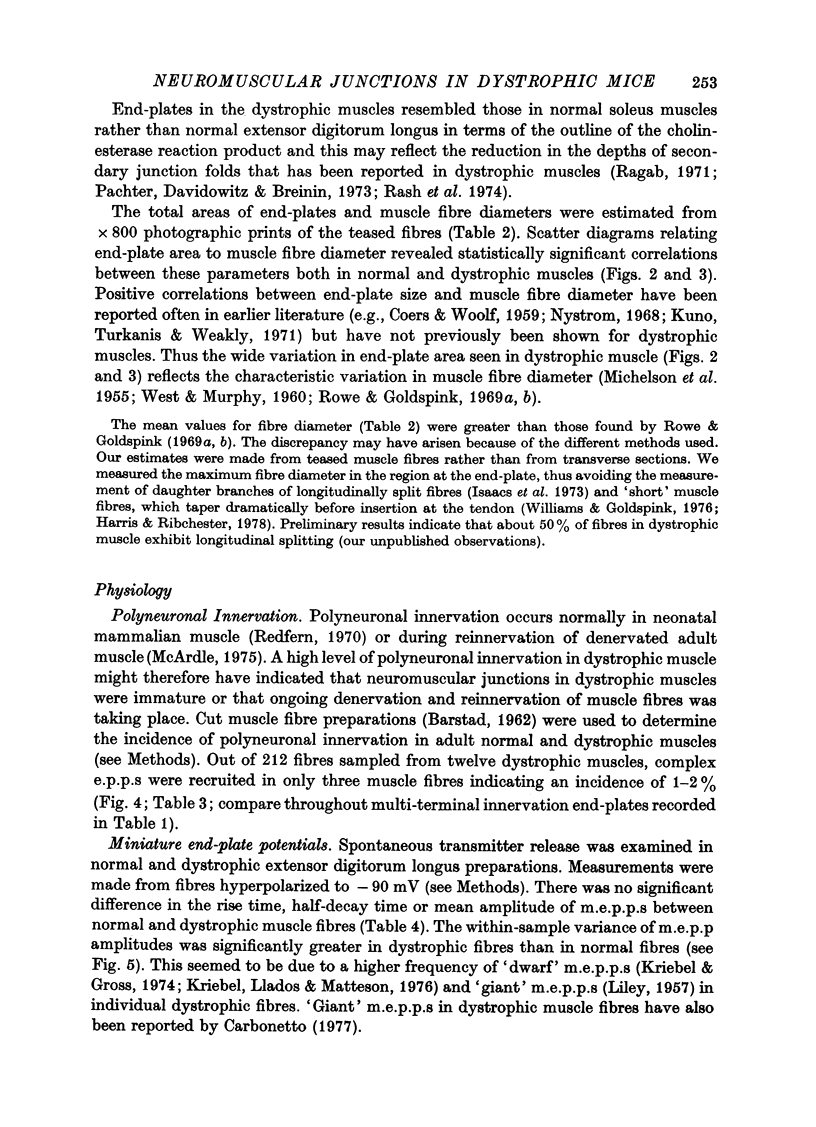





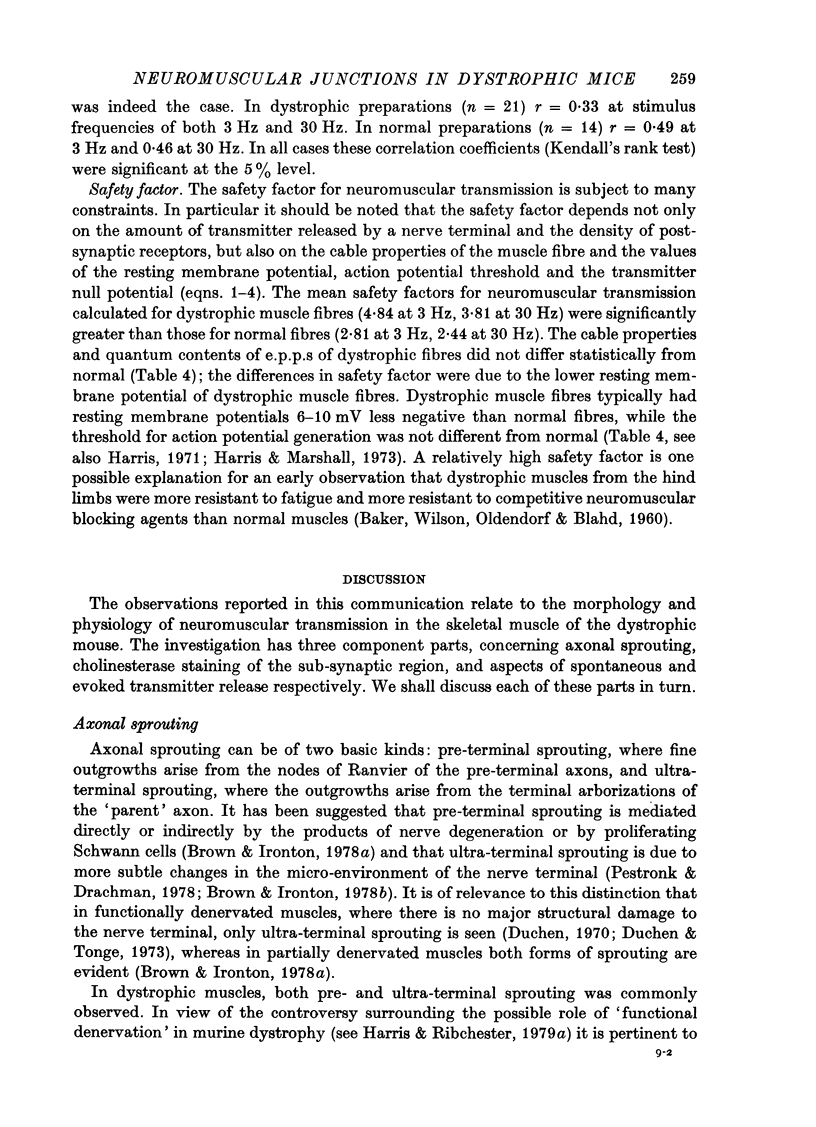

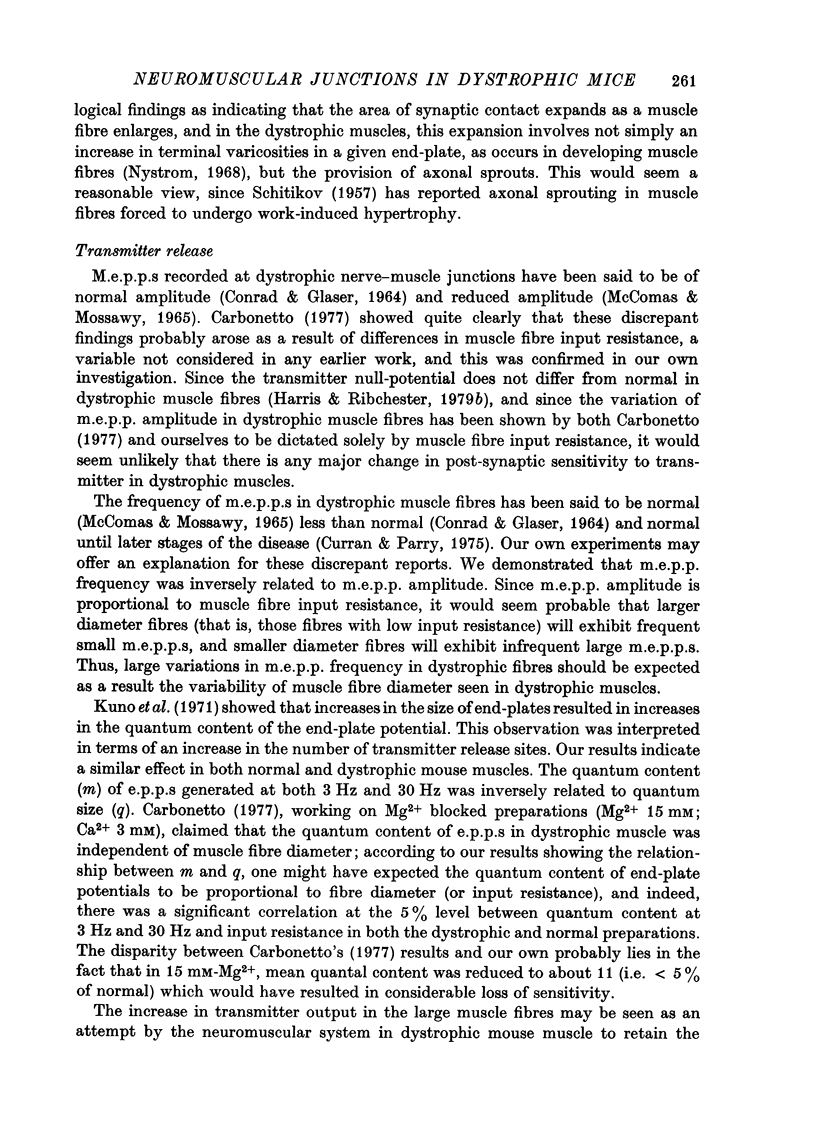






Images in this article
Selected References
These references are in PubMed. This may not be the complete list of references from this article.
- Akert K., Sandri C. An electron-microscopic study of zinc iodide-osmium impregnation of neurons. I. Staining of synaptic vesicles at cholinergic junctions. Brain Res. 1968 Feb;7(2):286–295. doi: 10.1016/0006-8993(68)90104-2. [DOI] [PubMed] [Google Scholar]
- BAKER N., WILSON L., OLDENDORF W., BLAHD W. H. Supersensitivity to neostigmine and resistance to d-tubocurarine in mice with hereditary myopathy. Am J Physiol. 1960 May;198:926–930. doi: 10.1152/ajplegacy.1960.198.5.926. [DOI] [PubMed] [Google Scholar]
- BARRNETT R. J. The fine structural localization of acetylcholinesterase at the myoneural junction. J Cell Biol. 1962 Feb;12:247–262. doi: 10.1083/jcb.12.2.247. [DOI] [PMC free article] [PubMed] [Google Scholar]
- BARSTAD J. A. Presynaptic effect of the neuro-muscular transmitter. Experientia. 1962 Dec 15;18:579–580. doi: 10.1007/BF02172193. [DOI] [PubMed] [Google Scholar]
- Barker D., Ip M. C. Sprouting and degeneration of mammalian motor axons in normal and de-afferentated skeletal muscle. Proc R Soc Lond B Biol Sci. 1966 Jan 18;163(993):538–554. doi: 10.1098/rspb.1966.0008. [DOI] [PubMed] [Google Scholar]
- Biscoe T. J., Headley P. M., Martin M. R., Stirling C. A. Electrophysiological observations on the spinal cord of the normal and dystrophic mouse. J Neurol Sci. 1977 Jan-Feb;31(1):51–61. doi: 10.1016/0022-510x(77)90005-3. [DOI] [PubMed] [Google Scholar]
- Bradley W. G., Jenkison M. Abnormalities of peripheral nerves in murine muscular dystrophy. J Neurol Sci. 1973 Feb;18(2):227–247. doi: 10.1016/0022-510x(73)90009-9. [DOI] [PubMed] [Google Scholar]
- Brown M. C., Holland R. L., Ironton R. Variations in the amount and type of alpha-motoneurone sprouting following partial denervation of different mouse muscles [proceedings]. J Physiol. 1978 Nov;284:177P–178P. [PubMed] [Google Scholar]
- Brown M. C., Ironton R. Sprouting and regression of neuromuscular synapses in partially denervated mammalian muscles. J Physiol. 1978 May;278:325–348. doi: 10.1113/jphysiol.1978.sp012307. [DOI] [PMC free article] [PubMed] [Google Scholar]
- CONRAD J. T., GLASER G. H. SPONTANEOUS ACTIVITY AT MYONEURAL JUNCTION IN DYSTROPHIC MUSCLE. Arch Neurol. 1964 Sep;11:310–316. doi: 10.1001/archneur.1964.00460210088009. [DOI] [PubMed] [Google Scholar]
- Carbonetto S. Neuromuscular transmission in dystrophic mice. J Neurophysiol. 1977 Jul;40(4):836–843. doi: 10.1152/jn.1977.40.4.836. [DOI] [PubMed] [Google Scholar]
- Curran M., Parry D. J. Neuromuscular function in fast and slow muscles of genetically dystrophic mice. Exp Neurol. 1975 Apr;47(1):150–161. doi: 10.1016/0014-4886(75)90243-5. [DOI] [PubMed] [Google Scholar]
- DEL CASTILLO J., KATZ B. Quantal components of the end-plate potential. J Physiol. 1954 Jun 28;124(3):560–573. doi: 10.1113/jphysiol.1954.sp005129. [DOI] [PMC free article] [PubMed] [Google Scholar]
- Davis R., Koelle G. B. Electron microscopic localization of acetylcholinesterase and nonspecific cholinesterase at the neuromuscular junction by the gold-thiocholine and gold-thiolacetic acid methods. J Cell Biol. 1967 Jul;34(1):157–171. doi: 10.1083/jcb.34.1.157. [DOI] [PMC free article] [PubMed] [Google Scholar]
- Duchen L. W. An electron microscopic comparison of motor end-plates of slow and fast skeletal muscle fibres of the mouse. J Neurol Sci. 1971 Sep;14(1):37–45. doi: 10.1016/0022-510x(71)90128-6. [DOI] [PubMed] [Google Scholar]
- Duchen L. W. Hereditary disorders of motor and sensory neurons in the mouse. Ann N Y Acad Sci. 1979;317:506–511. doi: 10.1111/j.1749-6632.1979.tb56569.x. [DOI] [PubMed] [Google Scholar]
- Duchen L. W., Tonge D. A. The effects of tetanus toxin on neuromuscular transmission and on the morphology of motor end-plates in slow and fast skeletal muscle of the mouse. J Physiol. 1973 Jan;228(1):157–172. doi: 10.1113/jphysiol.1973.sp010078. [DOI] [PMC free article] [PubMed] [Google Scholar]
- Elmqvist D., Quastel D. M. A quantitative study of end-plate potentials in isolated human muscle. J Physiol. 1965 Jun;178(3):505–529. doi: 10.1113/jphysiol.1965.sp007639. [DOI] [PMC free article] [PubMed] [Google Scholar]
- Fewings J. D., Harris J. B., Johnson M. A., Bradley W. G. Progressive denervation of skeletal muscle induced by spinal irradiation in rats. Brain. 1977 Mar;100(Pt 1):157–183. doi: 10.1093/brain/100.1.157. [DOI] [PubMed] [Google Scholar]
- Glaser G. H., Seashore M. R. End-plate cholinesterase in dystrophic muscle. Nature. 1967 Jun 24;214(5095):1351–1351. doi: 10.1038/2141351a0. [DOI] [PubMed] [Google Scholar]
- Harris J. B., Marshall M. W. A study of action potential generation in murine dystrophy with reference to "functional denervation". Exp Neurol. 1973 Nov;41(2):331–344. doi: 10.1016/0014-4886(73)90274-4. [DOI] [PubMed] [Google Scholar]
- Harris J. B., Ribchester R. R. Muscular dystrophy in the mouse: neuromuscular transmission and the concept of functional denervation. Ann N Y Acad Sci. 1979;317:152–170. doi: 10.1111/j.1749-6632.1979.tb56522.x. [DOI] [PubMed] [Google Scholar]
- Harris J. B., Ribchester R. R. Neuromuscular transmission is adequate in identified abnormal dystrophic muscle fibres. Nature. 1978 Jan 26;271(5643):362–364. doi: 10.1038/271362a0. [DOI] [PubMed] [Google Scholar]
- Harris J. B., Ribchester R. R. Pharmacological aspects of neuromuscular transmission in the isolated diaphragm of the dystrophic (Rej 129) mouse. Br J Pharmacol. 1979 Mar;65(3):411–421. doi: 10.1111/j.1476-5381.1979.tb07845.x. [DOI] [PMC free article] [PubMed] [Google Scholar]
- Harris J. B. The resting membrane potential of fibres of fast and slow twitch muscles in normal and dystrophic mice. J Neurol Sci. 1971 Jan;12(1):45–52. doi: 10.1016/0022-510x(71)90250-4. [DOI] [PubMed] [Google Scholar]
- Harris J. B., Wallace C., Wing J. Myelinated nerve fibre counts in the nerves of normal and dystrophic mouse muscle. J Neurol Sci. 1972 Mar;15(3):245–249. doi: 10.1016/0022-510x(72)90067-6. [DOI] [PubMed] [Google Scholar]
- Huizar P., Kuno M., Miyata Y. Electrophysiological properties of spinal motoneurones of normal and dystrophic mice. J Physiol. 1975 Jun;248(1):231–246. doi: 10.1113/jphysiol.1975.sp010971. [DOI] [PMC free article] [PubMed] [Google Scholar]
- Jansen J. K., Van Essen D. C. Re-innervation of rat skeleton muscle in the presence of alpha-bungarotoxin. J Physiol. 1975 Sep;250(3):651–667. doi: 10.1113/jphysiol.1975.sp011075. [DOI] [PMC free article] [PubMed] [Google Scholar]
- KARNOVSKY M. J., ROOTS L. A "DIRECT-COLORING" THIOCHOLINE METHOD FOR CHOLINESTERASES. J Histochem Cytochem. 1964 Mar;12:219–221. doi: 10.1177/12.3.219. [DOI] [PubMed] [Google Scholar]
- KATZ B., THESLEFF S. On the factors which determine the amplitude of the miniature end-plate potential. J Physiol. 1957 Jul 11;137(2):267–278. doi: 10.1113/jphysiol.1957.sp005811. [DOI] [PMC free article] [PubMed] [Google Scholar]
- Kriebel M. E., Gross C. E. Multimodal distribution of frog miniature endplate potentials in adult denervated and tadpole leg muscle. J Gen Physiol. 1974 Jul;64(1):85–103. doi: 10.1085/jgp.64.1.85. [DOI] [PMC free article] [PubMed] [Google Scholar]
- Kriebel M. E., Llados F., Matteson D. R. Spontaneous subminature end-plate potentials in mouse diaphragm muscle: evidence for synchronous release. J Physiol. 1976 Nov;262(3):553–581. doi: 10.1113/jphysiol.1976.sp011610. [DOI] [PMC free article] [PubMed] [Google Scholar]
- Kuno M., Turkanis S. A., Weakly J. N. Correlation between nerve terminal size and transmitter release at the neuromuscular junction of the frog. J Physiol. 1971 Mar;213(3):545–556. doi: 10.1113/jphysiol.1971.sp009399. [DOI] [PMC free article] [PubMed] [Google Scholar]
- LILEY A. W. Spontaneous release of transmitter substance in multiquantal units. J Physiol. 1957 May 23;136(3):595–605. doi: 10.1113/jphysiol.1957.sp005784. [DOI] [PMC free article] [PubMed] [Google Scholar]
- MARTIN A. R. A further study of the statistical composition on the end-plate potential. J Physiol. 1955 Oct 28;130(1):114–122. doi: 10.1113/jphysiol.1955.sp005397. [DOI] [PMC free article] [PubMed] [Google Scholar]
- Madrid R. E., Jaros E., Cullen M. J., Bradley W. G. Genetically determined defect of Schwann cell basement membrane in dystrophic mouse. Nature. 1975 Sep 25;257(5524):319–321. doi: 10.1038/257319a0. [DOI] [PubMed] [Google Scholar]
- Martin A. R. The effect of membrane capacitance on non-linear summation of synaptic potentials. J Theor Biol. 1976 Jun;59(1):179–187. doi: 10.1016/s0022-5193(76)80031-8. [DOI] [PubMed] [Google Scholar]
- McArdle J. J. Complex end-plate potentials at the regenerating neuromuscular junction of the rat. Exp Neurol. 1975 Dec;49(3):629–638. doi: 10.1016/0014-4886(75)90048-5. [DOI] [PubMed] [Google Scholar]
- Michelson A. M., Russell E. S., Harman P. J. Dystrophia Muscularis: A HEREDITARY PRIMARY MYOPATHY IN THE HOUSE MOUSE. Proc Natl Acad Sci U S A. 1955 Dec 15;41(12):1079–1084. doi: 10.1073/pnas.41.12.1079. [DOI] [PMC free article] [PubMed] [Google Scholar]
- Montgomery A., Swenarchuk L. Further observations on myelinated axon numbers in normal and dystrophic mice. J Neurol Sci. 1978 Aug;38(1):77–82. doi: 10.1016/0022-510x(78)90247-2. [DOI] [PubMed] [Google Scholar]
- Nyström B. Postnatal development of motor nerve terminals in "slow-red" and "fast-white" cat muscles. Acta Neurol Scand. 1968;44(3):363–383. doi: 10.1111/j.1600-0404.1968.tb05578.x. [DOI] [PubMed] [Google Scholar]
- Pachter B. R., Davidowitz J., Breinin G. M. Morphological changes associated with the myoneural junction in extraocular muscle of the dystrophic mouse. Acta Neuropathol. 1973 May 16;24(3):214–221. doi: 10.1007/BF00687591. [DOI] [PubMed] [Google Scholar]
- Pestronk A., Drachman D. B. Motor nerve sprouting and acetylcholine receptors. Science. 1978 Mar 17;199(4334):1223–1225. doi: 10.1126/science.204007. [DOI] [PubMed] [Google Scholar]
- Ragab A. H. Motor-end-plate changes in mouse muscular dystrophy. Lancet. 1971 Oct 9;2(7728):815–816. doi: 10.1016/s0140-6736(71)92764-4. [DOI] [PubMed] [Google Scholar]
- Redfern P. A. Neuromuscular transmission in new-born rats. J Physiol. 1970 Aug;209(3):701–709. doi: 10.1113/jphysiol.1970.sp009187. [DOI] [PMC free article] [PubMed] [Google Scholar]
- Rowe R. W., Goldspink G. Muscle fibre growth in five different muscles in both sexes of mice. II. Dystrophic mice. J Anat. 1969 May;104(Pt 3):531–538. [PMC free article] [PubMed] [Google Scholar]
- Rowe R. W., Goldspink G. Muscle fibre growth in five different muscles in both sexes of mice. J Anat. 1969 May;104(Pt 3):519–530. [PMC free article] [PubMed] [Google Scholar]
- Sidman R. L., Cowen J. S., Eicher E. M. Inherited muscle and nerve diseases in mice: a tabulation with commentary. Ann N Y Acad Sci. 1979;317:497–505. doi: 10.1111/j.1749-6632.1979.tb56567.x. [DOI] [PubMed] [Google Scholar]
- Stirling C. A. Abnormalities in Schwann cell sheaths in spinal nerve roots of dystrophic mice. J Anat. 1975 Feb;119(Pt 1):169–180. [PMC free article] [PubMed] [Google Scholar]
- Tuffery A. R. Growth and degeneration of motor end-plates in normal cat hind limb muscles. J Anat. 1971 Nov;110(Pt 2):221–247. [PMC free article] [PubMed] [Google Scholar]
- WEST W. T., MURPHY E. D. Histopathology of hereditary, progressive muscular dystrophy in inbred strain 129 mice. Anat Rec. 1960 Jul;137:279–295. doi: 10.1002/ar.1091370306. [DOI] [PubMed] [Google Scholar]
- Williams P. E., Goldspink G. The effect of denervation and dystrophy on the adaptation of sarcomere number to the functional length of the muscle in young and adult mice. J Anat. 1976 Nov;122(Pt 2):455–465. [PMC free article] [PubMed] [Google Scholar]














